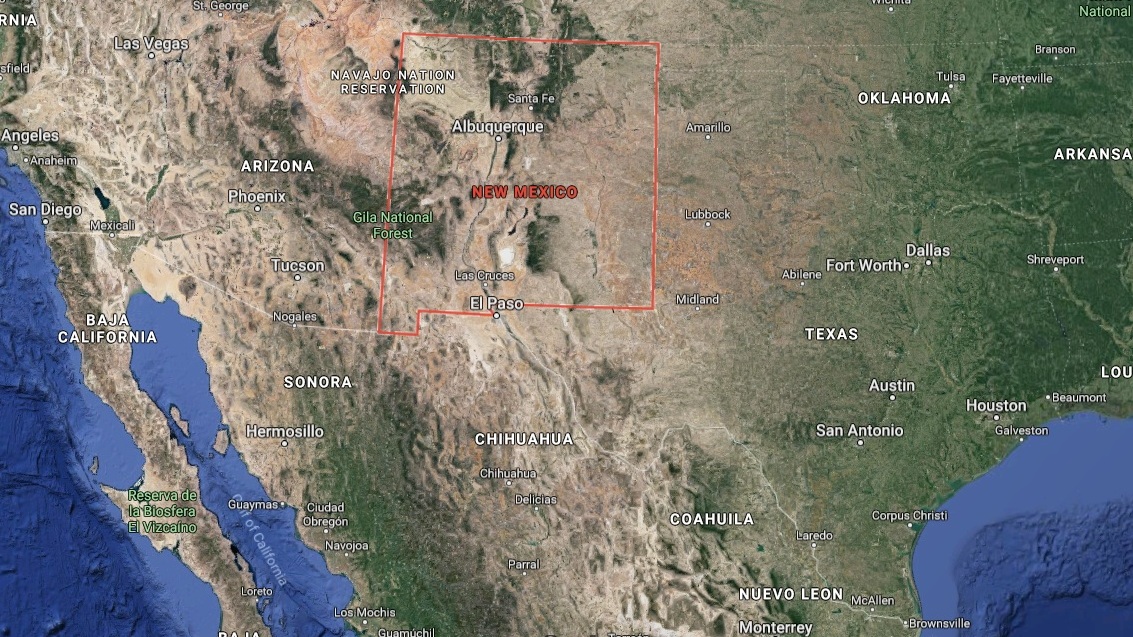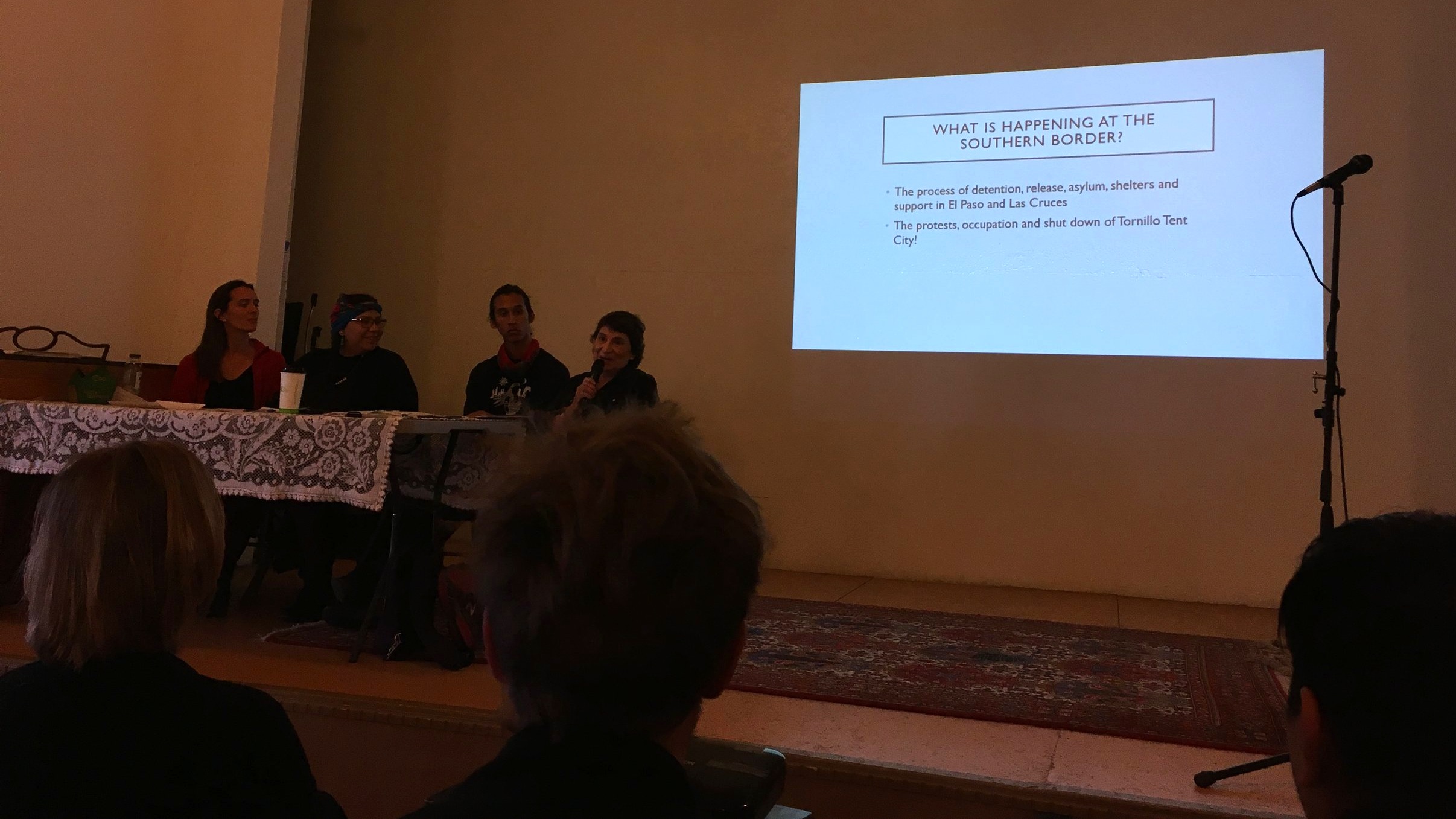After attending Saturday’s panel presentation, I spent most of the day Sunday going through the notes I scribbled, photos I took, and a few audio clips I recorded. Here’s my transcription of Sayrah’s story.
I volunteer at a makeshift shelter based out of a church in Las Cruces. All of us who volunteer there have had a background check, we all were trained, we’re very very concerned about preventing—the history of the Catholic Church is unfortunately at play, so they’re really scrupulous about providing checks and training for people who are working in the shelter. Everyone that’s there is a parent with children.
The way that it works is the detention centers are very full. Recently an article in the El Paso Times talked about cells designed to hold ten people holding closer to thirty or fifty people. Migrants tell us they’re getting one bottle of water a day. And so when we think about the young girl who died in New Mexico, her father says she was given one bottle of water a day. I can’t go on one bottle of water, especially if I had come from a journey. There’s freezing temperatures, it’s really horrible for people. And they’re kept in cells, and they’re sleeping on cement floors.
When they come to our shelter, they’re being released because of the ruling that children cannot be kept longer than I believe it was 21 days. So they’re being released with their parents.
I.C.E. actually drops them off at our shelter. They have this very tenuous situation where they’re releasing people to shelters into Las Cruces. They create a lot of chaos, they don’t communicate, they’re very difficult. We don’t have good things to say about them, but they do have to release people somewhere and we’re willing to support people that are released.
When they first get released, they have nothing but the clothes on their back. Many of them have experienced tremendous violence, they have had everything taken from them, and they have nothing. They’ve been through a lot of trauma.
We, before they get there, we set up the shelter with cots, which is better than the cement floor they’ve been on. We get new clothing for them so they can have a change of clothes. We have hot showers so they can shower. They have no clothes except the ones they journeyed in. We make a caldo, it’s a really healthy comfort food with like chicken and veggie stew, we have tortillas, we have oranges and fruit, we have a volunteer doctor who does a medical assessment on everyone who comes in, and there are really people who are sick and children who are sick. This is all volunteer staff. It’s all donations, we use donations to run it.
When they come off the bus, they don’t know where they’re coming to and they’re very afraid. All they’ve experienced has been people being horrible to them. And so we make a welcome line so as they come off the bus and they enter the shelter, we’re welcoming them, we hug them, we greet them. When we serve them caldo we sit with them and we eat with them, we’re not standing over them, we’re eating with them. If they want to tell us their story they can, but we don’t question them. We just want to eat with them.
The children start to warm up. There’s toys, they realize it’s not a detention center. The first thing they notice is there’s a hallway, they can run. Some of them start running up and down the hallway! I mean, they’ve been locked up in jail. Up until now they’ve been on a journey where they have to be quiet, they have to hide—and now they can play, they can run. Some of the kids are too traumatized and they don’t run in the hallway, they sit in the corner and we might get a puzzle out for them.
People are able to go shower, pick out fresh clothing. Some of the women have been carrying babies and we offer to hold their babies so they can finally shower and to give them a break.
And then we have a travel room. That’s the room people really want to go to, and everyone gets to eventually, it takes all day and all evening. It’s the first time they can use a phone. We give them our phones and they call their family. They call their sponsor. One time a man took my phone and the battery was dead so he brought it back, but he was so happy to finally get to talk to someone, to say “I’m safe, I made it, how do I get to you?”
Everyone needs to get to their sponsor. And their sponsor is not in New Mexico. So at this point they have the case for asylum, and their sponsor might be in Kentucky, Indiana, Florida, or Rhode Island, Wisconsin, West Virginia, and we have to get people all over the country. So in the travel room, we have all our volunteers, and our job is to help find a bus or a plane ticket that can get them from Las Cruces to wherever they’re going.
I had a woman ask me, how far is it by bus to Kentucky? I said maybe two or three days, and she just started crying. She had all these children with her, and she thought she was finally to her sponsor. But our country is so large, land-wise, and so, she was just realizing that.
So. We stay up till ten o’clock at night trying to get everyone’s bus tickets. Then people can sleep there, and in the morning we have another group of volunteers that takes people to the bus station and the airport. People have not ridden our planes, some of them don’t speak English, they don’t speak Spanish, they only speak their indigenous language. So this is a really hard process of like, how do you get people on the bus that’s gonna transfer from here to Texas, Texas to Atlanta, Atlanta to Florida, Florida to—I mean, trying to explain that.
The donations you brought today for food, for snacks—we don’t always have money to give people. And so we’re packing their bags with as many healthy snacks as we can, because they might be on a 3-day bus journey with children and no money. Someone really generous in Albuquerque at a donation drive just put an envelope full of $20 bills. I don’t know who it was. I was so moved that they trusted me. It felt so good to go down there that night and give a $20 bill to every person that was getting on the bus with their children. I though, okay, at least I know that they’ve got $20 between here and Rhode Island.
I want to lift up these incredible women in Las Cruces. It’s almost entirely women, I was comparing notes with Eleanor in El Paso and it’s almost entirely women there too doing this work at Annunciation House. These are the people who are resisting. These are the people who are showing a different version than the oppressive system that we’re in. We need radical system change, but we also need to help people each day. We need both.







































